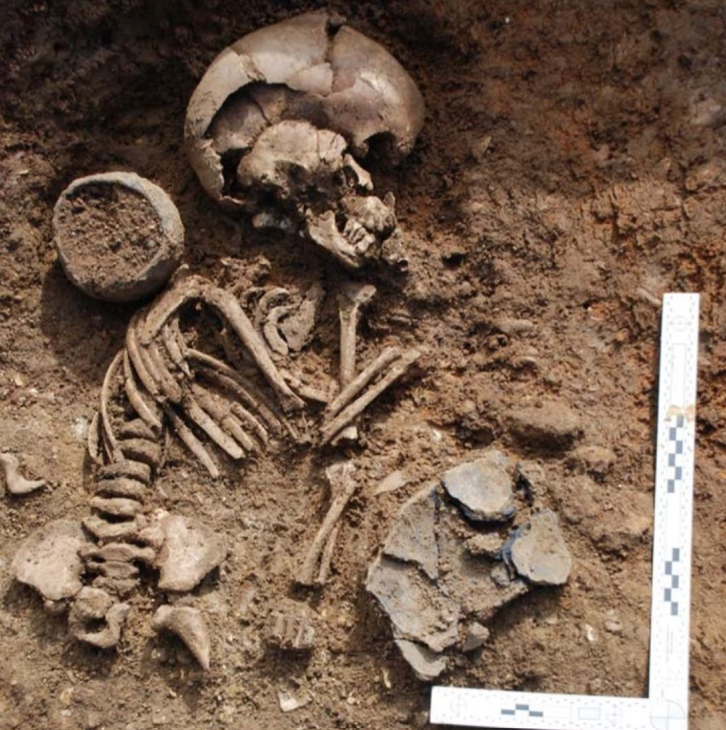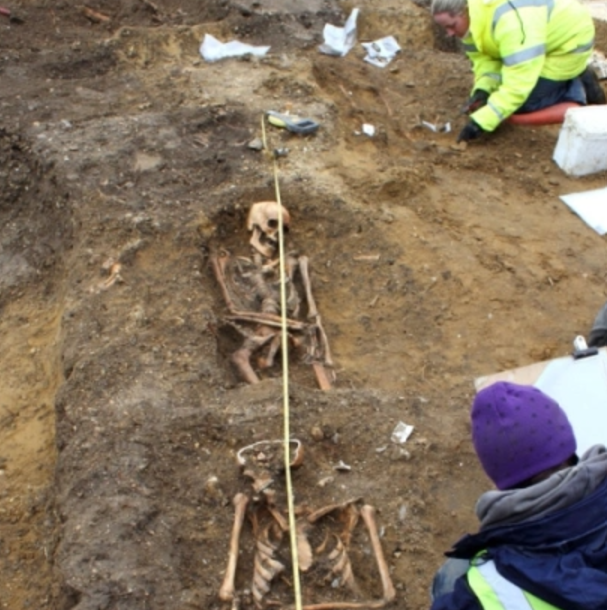In 2014, an extraordinary find captivated the world of archaeology—a 6th-century Anglo-Saxon burial site in Cambridgeshire revealed the remains of a woman with a modern gas pipe running through her skull. This peculiar discovery not only piqued public curiosity but also underscored the complexities of uncovering ancient burial sites in contemporary settings. The site, which contained over 100 skeletons, archeology.dulichvn.net, provided invaluable insights into Anglo-Saxon life, while the bizarre positioning of the gas pipe offered a fascinating glimpse into the intersection of history and modern infrastructure.
Unveiling the Anglo-Saxon Burial Site
The Initial Discovery
The excavation in Cambridgeshire began as part of a routine archaeological survey conducted before a construction project. What initially seemed like a standard dig quickly turned extraordinary when researchers unearthed a burial site dating back to the 6th century. Among the 100 skeletons found, one stood out—a woman whose skull was pierced by a gas pipe, a stark reminder of the modern world’s inadvertent impact on historical sites.

The burial site reflected the burial practices and social structure of the Anglo-Saxon period, offering a treasure trove of artifacts and skeletal remains for analysis.
The Gas Pipe Mystery
The gas pipe’s presence in the woman’s skull was a quirk of fate. Installed during modern construction, the pipe had unknowingly passed through the ancient burial ground. This oversight highlights the delicate balance between development and preservation, raising questions about how best to protect historical sites in rapidly expanding urban areas.
Despite the unusual intrusion, the woman’s remains remained remarkably well preserved, allowing archaeologists to study her physical characteristics and speculate about her life.
Significance of the Burial Site
The Cambridgeshire burial site is one of the most significant Anglo-Saxon discoveries in recent years. Its size and variety of burials provide a snapshot of the community’s demographic composition, social hierarchy, and cultural practices. From warriors buried with weapons to women adorned with jewelry, each grave tells a unique story of life during this fascinating period.
See more: The Etruscan Tomb of Five Chairs: A Journey into Ancient Burial Traditions
Insights into Anglo-Saxon Life
Who Was the Woman with the Gas Pipe?
While little is known about the woman’s identity, her burial offers clues to her life and status. Analysis of her skeleton revealed she was likely in her mid-30s at the time of her death. Her burial placement, along with the lack of accompanying grave goods, suggests she may have been of modest social standing.

The absence of elaborate adornments contrasts sharply with other graves at the site, where wealthier individuals were buried with ornate brooches, beads, and weapons. Nonetheless, her discovery underscores the importance of every individual in piecing together the broader narrative of Anglo-Saxon society.
Daily Life in the 6th Century
The Anglo-Saxon period, spanning from the 5th to the 11th centuries, was characterized by a rural, agrarian lifestyle. Communities were tightly knit, with social roles defined by gender and status. Men typically worked as warriors, farmers, or craftsmen, while women often managed households and engaged in textile production.
The burial site provides a glimpse into these roles, with male graves often containing weapons and tools, while female graves include spindle whorls, beads, and other domestic artifacts. These items highlight the gendered division of labor and the skills valued in Anglo-Saxon communities.
Health and Nutrition
The skeletal remains at the Cambridgeshire site reveal much about the health and diet of the Anglo-Saxon population. The woman with the gas pipe, like many others, showed signs of dental wear, indicative of a diet heavy in coarse grains. Evidence of arthritis and other age-related conditions also suggests a life of physical labor, consistent with the demands of an agrarian lifestyle.
See more: The Riemerschmidt BMW Schneekrad: A Rare Glimpse into Early Snowmobile Innovation
Modern Challenges in Archaeology
Impact of Urban Development
The discovery of the gas pipe serves as a stark reminder of the challenges posed by modern infrastructure. With expanding cities and increasing construction, the risk of disturbing historical sites is ever-present. This case highlights the importance of thorough archaeological surveys and the need for collaboration between developers and preservationists.

While the gas pipe’s intrusion was accidental, it raises questions about the potential damage to undiscovered sites. Striking a balance between progress and preservation is essential to safeguarding cultural heritage.
Preservation Efforts
Preserving archaeological finds like the Cambridgeshire burial site requires meticulous planning and resources. Once unearthed, skeletons and artifacts must be carefully documented, cleaned, and stored to prevent deterioration. In the case of the Anglo-Saxon woman, her remains have been studied extensively, ensuring her story contributes to our understanding of the past.
Digital archiving and 3D modeling have also become valuable tools in preserving and sharing discoveries. These technologies allow researchers and the public to explore historical finds without compromising their integrity.
Public Engagement
Engaging the public is a crucial aspect of modern archaeology. The unusual story of the gas pipe through the woman’s skull captured widespread attention, sparking interest in Anglo-Saxon history. By making discoveries accessible and relatable, archaeologists can inspire a deeper appreciation for the past and its relevance to contemporary life.
The Legacy of the Cambridgeshire Discovery
Advancing Archaeological Knowledge
The Cambridgeshire burial site has significantly advanced our understanding of Anglo-Saxon England. Each skeleton and artifact contributes to a richer narrative of life, death, and cultural practices during this period.

The woman with the gas pipe, in particular, serves as a poignant example of how the past and present intersect in unexpected ways. Her story reminds us of the need to approach development with care and respect for the history beneath our feet.
A Call for Preservation
The discovery underscores the importance of preserving archaeological sites for future generations. With proper funding, legislation, and public support, it is possible to protect and study these invaluable windows into the past.
As urbanization continues to encroach on historical landscapes, the Cambridgeshire site serves as a reminder of the fragile nature of our shared heritage.
Inspiring Future Research
The story of the Anglo-Saxon burial site continues to inspire researchers, students, and history enthusiasts worldwide. Its lessons extend beyond the academic realm, emphasizing the interconnectedness of history and modern society.
Conclusion: Bridging Past and Present
The discovery of the 6th-century Anglo-Saxon woman with a gas pipe through her skull is a testament to the surprises archaeology can unveil. Beyond its peculiar nature, the find offers a profound connection to a bygone era, shedding light on the lives, beliefs, and challenges of Anglo-Saxon communities.
As we uncover these stories, we are reminded of the importance of preserving history in the face of modern development. The Cambridgeshire burial site not only enriches our understanding of the past but also inspires us to protect it for the future, ensuring that the voices of ancient civilizations continue to resonate in our world today.

CÁC TIN KHÁC
Mary Walton: The Forgotten Inventor Who Helped Clean Up America’s Cities
Tomb of Queen Nefertari in the Valley of the Queens, Egypt
Discover the Hypostyle Hall of the Temple of Hathor at Dendera
Venus de Losange: Unveiling the Mystery of a 20,000-Year-Old Paleolithic Icon